By: Dr. Kaviraj Khialani- Celebrity Master Chef.
Thai curry paste is a vibrant and essential component in Thai cuisine, embodying the heart and soul of Thai flavor profiles. It is a concentrated blend of herbs, spices, and aromatics ground together to form a smooth paste that serves as the foundational flavor base for a variety of Thai curries and dishes.
The ingredients commonly found in Thai curry pastes include chilies, lemongrass, galangal (a root similar to ginger but with a sharper flavor), garlic, shallots, kaffir lime leaves, cilantro roots, and spices such as coriander and cumin seeds.
Thai curry paste is not only about bringing heat to a dish but also about creating a deep, complex flavor foundation that is both aromatic and profoundly flavorful.
It can be used in traditional Thai curries, soups like Tom Yum and Tom Kha, stir-fries, and even as a marinade for meats and vegetables, showcasing its versatility in the kitchen.
Whether store-bought or homemade, Thai curry paste is a key ingredient in Thai cooking that delivers an authentic taste of Thailand’s culinary heritage.
ORIGIN
The origin of Thai curry paste can be traced back to the historical interactions and cultural exchanges between various civilizations in Southeast Asia and the broader Indian subcontinent. The concept of curry itself is believed to have roots in India, where a blend of spices
and herbs used for flavoring dishes has been a culinary tradition for thousands of years. As trade routes expanded, these culinary practices spread across Asia, including to Thailand. The introduction of chili peppers to Thailand in the late 16th to early 17th century by Portuguese traders also played a significant role in the development of Thai curry pastes.
Chili peppers became a staple ingredient, contributing to the heat and depth of flavor in Thai curries. Over the centuries, Thai curry paste has evolved into various forms, with each region in Thailand developing its own variations based on local ingredients and taste preferences. This has resulted in a wide variety of curry pastes, including the well-known green, red, and yellow curry pastes, each with its unique blend of ingredients and flavors.
HEALTH BENEFITS OF THAI CURRY PASTE
Thai curry paste, a blend of several herbs, spices, and aromatics, offers a range of health benefits owing to its nutrient-rich ingredients. Each component of the curry paste contributes to its overall health- promoting properties:
Anti-inflammatory properties: Many ingredients in Thai curry paste, such as turmeric (found in yellow curry paste), ginger, and garlic, have strong anti-inflammatory properties. These can help reduce inflammation in the body, which is beneficial for preventing chronic
diseases and relieving symptoms of conditions like arthritis.
Antioxidant-rich: Herbs and spices like lemongrass, galangal, and chilies are rich in antioxidants, which protect the body from damage caused by free radicals and can reduce the risk of various diseases, including heart disease and cancer.
Boosts metabolism: The capsaicin in chilies, a common ingredient in red and green curry pastes, has been shown to boost metabolism and promote fat burning, which can aid in weight management.
Enhances digestion: Many ingredients in Thai curry paste, such as galangal and lemongrass, have digestive properties that can help improve digestion and reduce gastrointestinal discomfort like bloating and gas.
Antimicrobial properties: Garlic, shallots, and chilies possess antimicrobial properties that can help fight against certain bacteria, viruses, and fungi, potentially reducing the risk of infections.
Heart health: Ingredients like garlic and turmeric have been associated with improved heart health by lowering blood pressure and cholesterol levels, reducing the risk of heart disease.
Immune system support: The combination of vitamins, minerals, and antioxidants found in the ingredients of Thai curry paste can strengthen the immune system, helping the body to fend off illnesses more effectively.
USES OF THAI CURRY PASTE IN KITCHEN
Thai curry paste is an incredibly versatile ingredient that can be used in various ways to infuse dishes with rich flavors and aromas characteristic of Thai cuisine. Here are some creative uses of Thai curry paste in the kitchen:
- Curries The most traditional use of Thai curry paste is in preparing curries. Mixed with coconut milk or water, it forms the base of both meat and vegetarian curries, providing depth and complexity to the dish.
- Soups
Thai curry paste can add a flavorful twist to soups. A spoonful of curry paste can transform simple ingredients into a fragrant and spicy broth, such as in the famous Thai dishes Tom Yum and Tom Kha Gai. - Marinades
Use the paste as a marinade for meats, seafood, or tofu before
grilling, roasting, or frying. The herbs and spices penetrate the
proteins, imparting a robust flavor that elevates the dish. - Stir-fries
Add a bit of Thai curry paste to your stir-fry sauce to give vegetables,
noodles, or rice a spicy and aromatic kick. It works great for adding a
quick and easy flavor boost to weeknight meals. - Dipping Sauces
Mix Thai curry paste with ingredients like coconut milk, yogurt, or
mayonnaise to create a unique and flavorful dipping sauce for
vegetables, chips, or grilled meats. - Salad Dressings
Incorporate a small amount of Thai curry paste into salad dressings to
add an unexpected and spicy element to your greens or noodle
salads. - Flavoring for Rice or Grains Stir a little curry paste into your cooking water for rice, quinoa, or other grains to lightly flavor them as they cook. This can be an excellent base for more elaborate dishes or bowls.
- Eggs
Enhance scrambled eggs, omelets, or frittatas with a teaspoon of curry paste for a breakfast with a Thai twist. - Spreads
Blend Thai curry paste into hummus, butter, or cream cheese to create a flavorful spread for sandwiches, wraps, or crackers. - Vegetable Dishes
Toss roasted or steamed vegetables with a bit of curry paste and olive oil before serving. It’s an easy way to add a burst of flavor to simple side dishes.
RECIPE USING THAI CURRY PASTE
1) Thai Red Curry Chicken
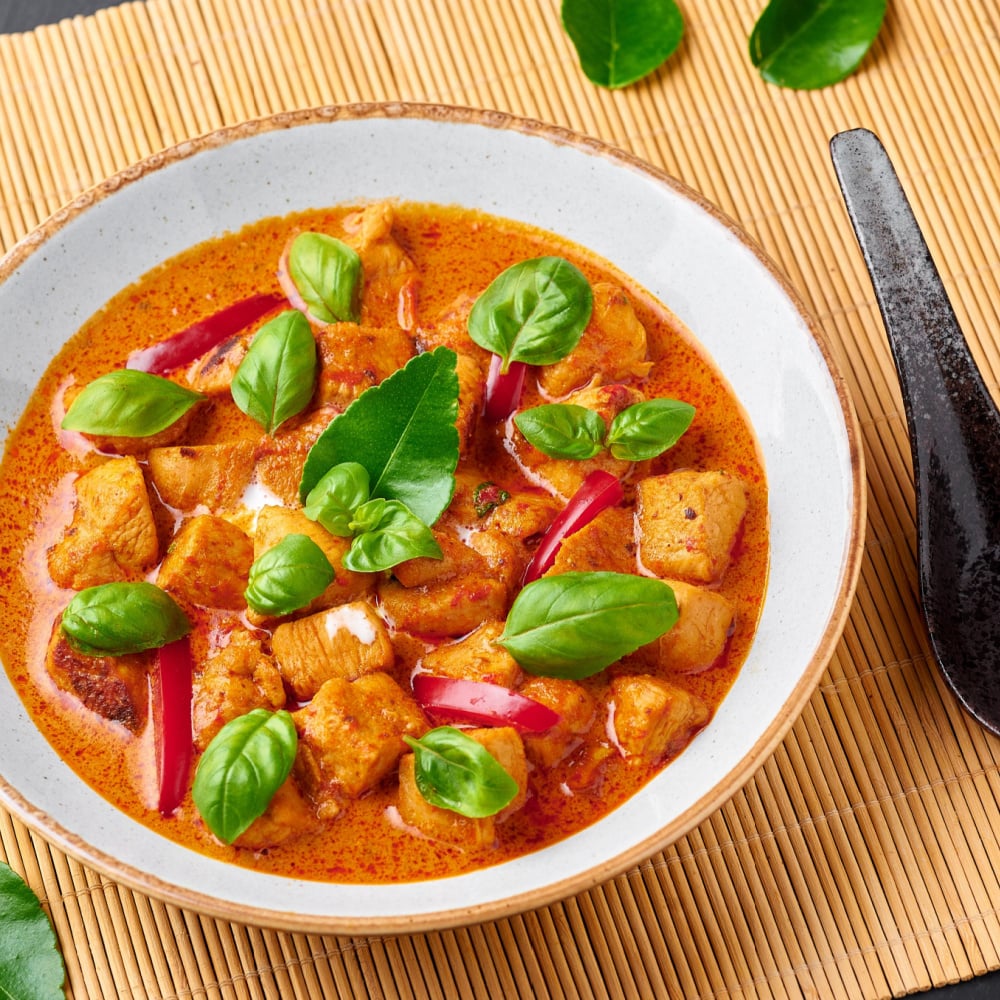
Ingredients:
- 2 tbsp red curry paste,
- 1 can coconut milk,
- 500g chicken breast (sliced),
- 1 bell pepper (sliced),
- 1 onion (sliced),
- 1 tbsp fish sauce,
- 1 tsp sugar,
- basil leaves
- oil
Instructions:
- Heat oil in a pan and fry the curry paste for a minute.
- Add the chicken and cook until it starts to brown.
- Pour in the coconut milk, add the bell pepper and onion, and simmer for about 20 minutes.
- Season with fish sauce and sugar. Garnish with basil leaves before serving.
2) Thai Curry Baked Fish
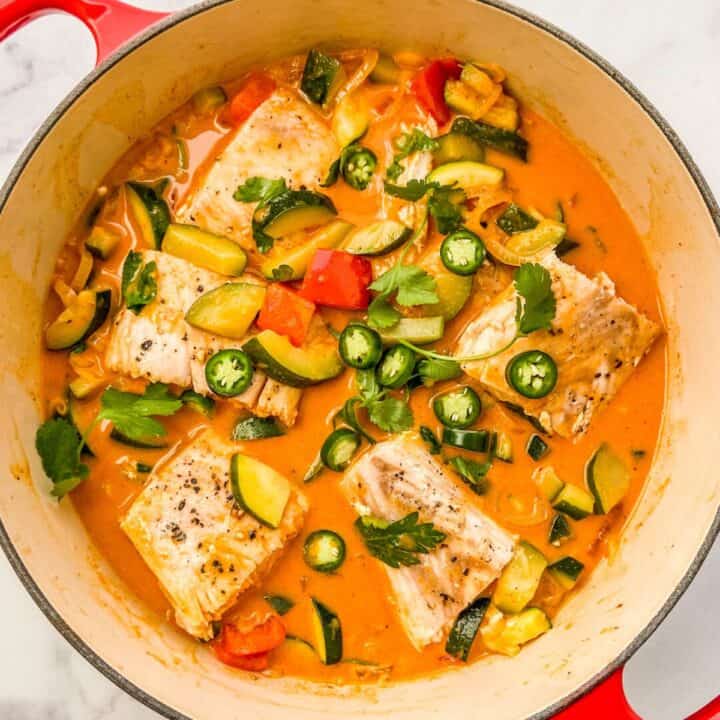
Ingredients:
- 4 fish fillets
- 2 tbsp yellow curry paste
- 1 can coconut milk
- 1 tbsp fish sauce
- 1 tsp sugar
- lime slices
- cilantro.
Instructions:
- Preheat oven to 180°C (350°F).
- Mix curry paste with coconut milk, fish sauce, and sugar. Place fish in a baking dish and pour the mixture over the fish.
- Bake for 20-25 minutes. Serve with lime slices and garnish with cilantro.
3) Spicy Thai Curry Meatballs
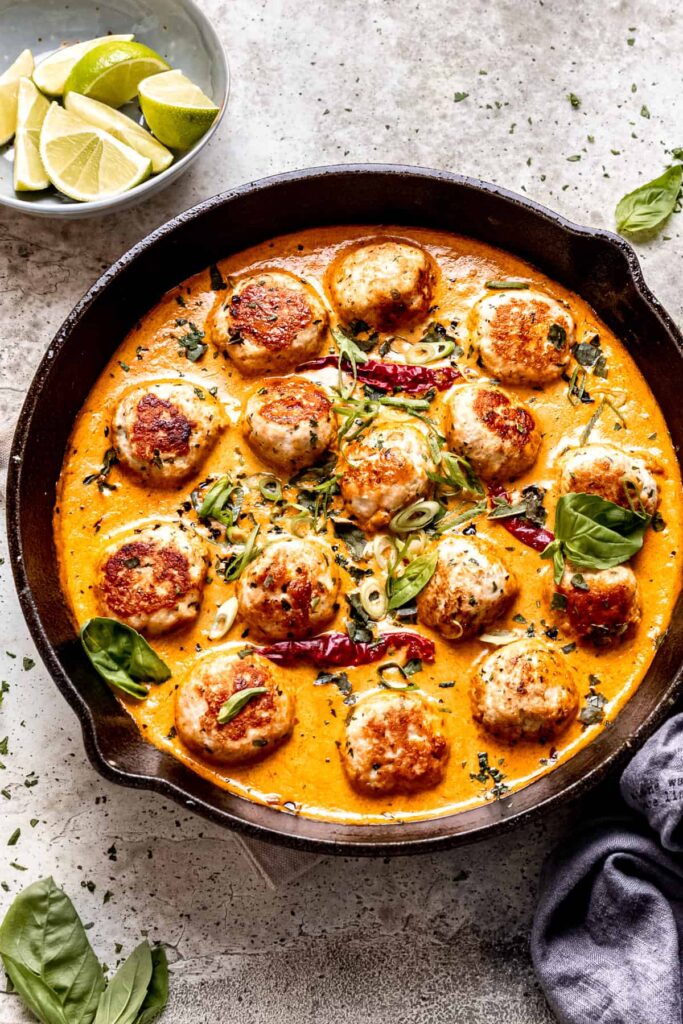
Ingredients:
- 500g ground meat (chicken or pork)
- 2 tbsp red curry paste
- 1 egg
- 1/2 cup breadcrumbs
- salt
- oil.
Instructions:
- Combine ground meat with curry paste, egg, breadcrumbs, and a pinch of salt. Mix well.
- Form into balls and fry in oil until cooked through.
- Serve with a dipping sauce or as part of a main dish with rice and vegetables.
4) Thai Curry Vegetable Soup
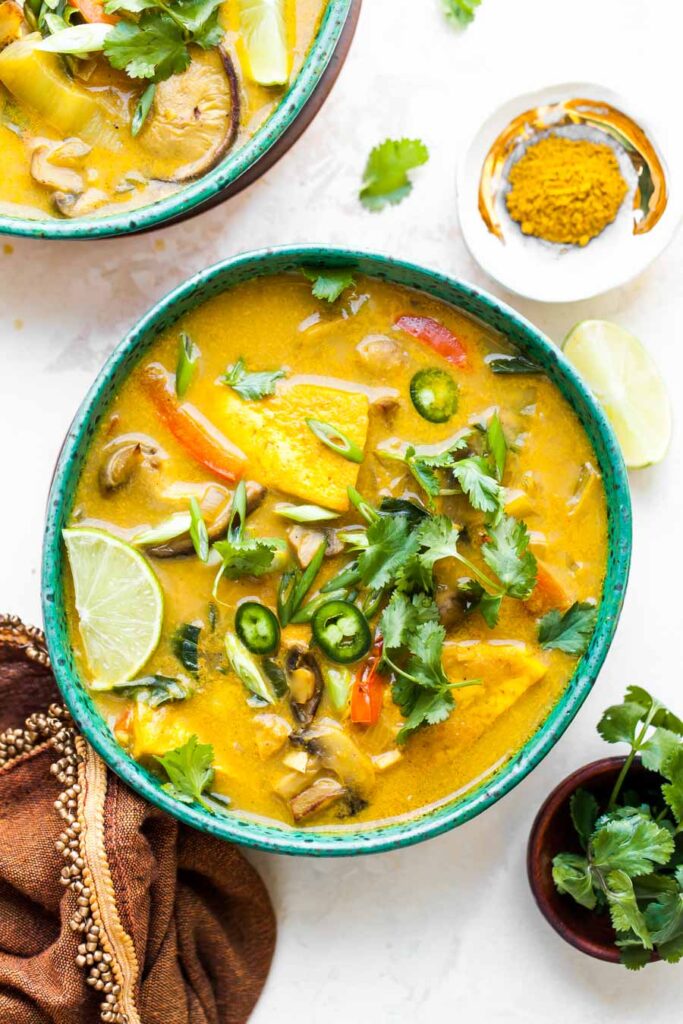
Ingredients:
- 1 tbsp green curry paste,
- 1 can coconut milk,
- 2 cups vegetable stock,
- 2 cups mixed vegetables (carrots, bell peppers, zucchini),
- 1 tbsp soy sauce
- 1 tsp sugar
- lime juice
- cilantro.
Instructions:
- In a pot, mix curry paste with a bit of coconut milk until smooth. Add the rest of the coconut milk and vegetable stock, and bring to a simmer.
- Add the vegetables and cook until tender.
- Season with soy sauce, sugar, and a squeeze of lime juice. Serve garnished with cilantro.
5) Thai Curry Pasta
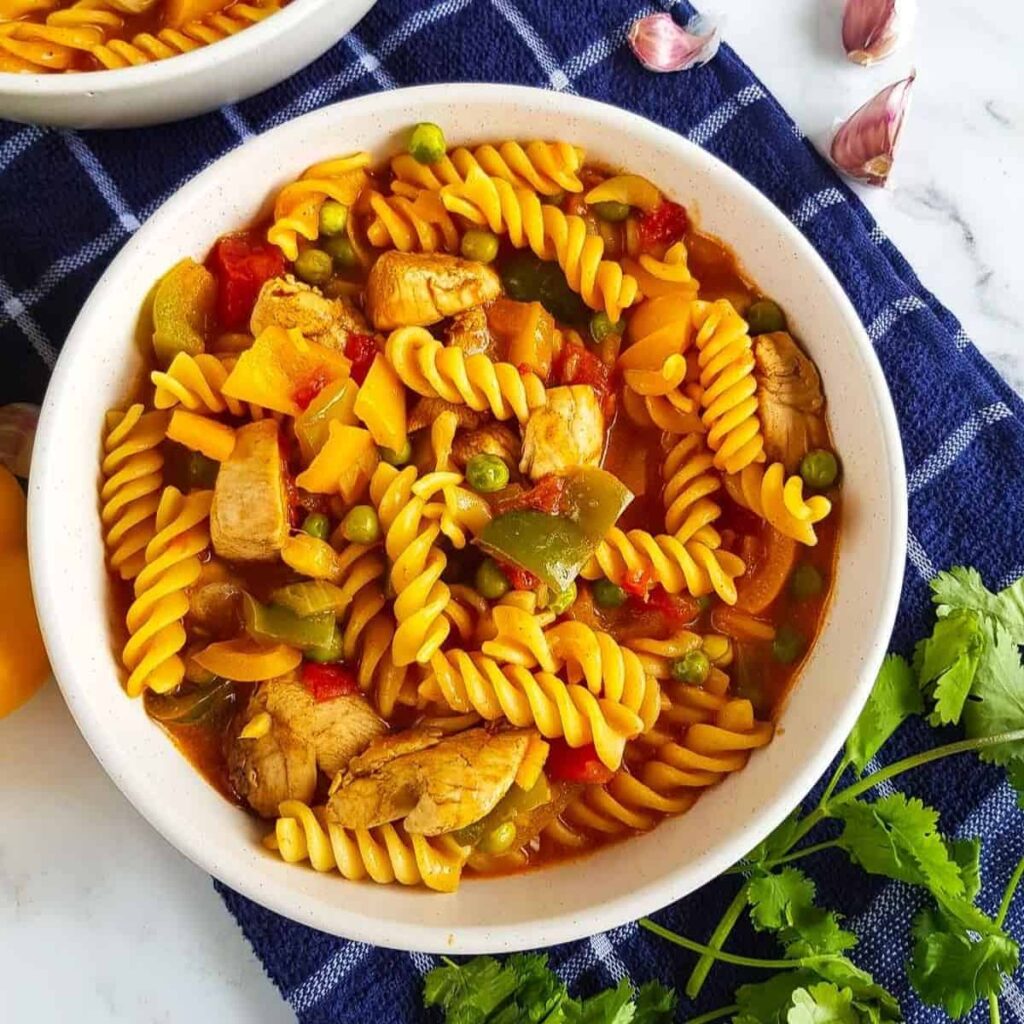
Ingredients:
- 200g pasta
- 1 tbsp red or green curry paste
- 1 can coconut milk
- 1 cup sliced mushrooms
- 1 bell pepper (sliced)
- 1 carrot (julienned)
- 1 tbsp soy sauce
- basil leaves.
Instructions:
- Cook pasta according to package instructions. Drain and set aside.
- In a pan, sauté curry paste with a bit of coconut milk. Add vegetables and cook until soft.
- Add the rest of the coconut milk and soy sauce, bringing to a light simmer.
- Toss in the cooked pasta and mix well. Garnish with basil leaves before serving.
6) Thai Curry Roasted Vegetables
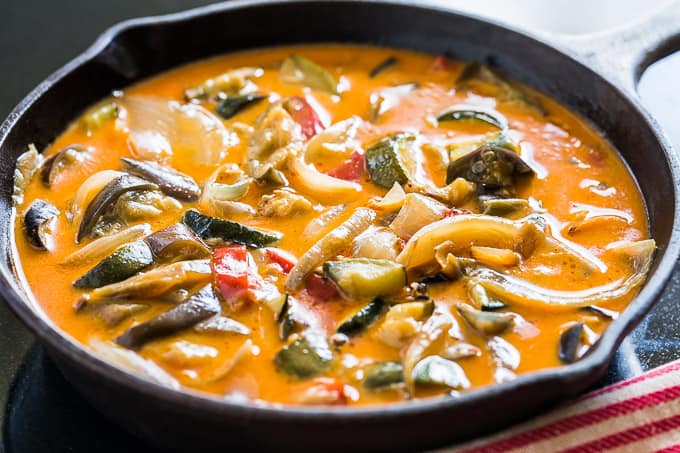
Ingredients:
- 2 cups mixed vegetables (potatoes, carrots, broccoli)
- 2 tbsp green curry paste
- 2 tbsp oil
- 1 can coconut milk
- salt
Instructions:
- Preheat oven to 200°C (400°F).
- Toss vegetables with curry paste, oil, and a pinch of salt.
- Spread on a baking sheet and roast until tender, about 25-30 minutes.
- Halfway through, drizzle with coconut milk and continue roasting.
INSTRUCTIONS:
- Before adding any liquids like coconut milk or water, heat a bit of oil in a pan and sauté the curry paste. This process, known as “blooming,” helps release the paste’s full range of flavors and fragrances. Cook it until it becomes aromatic, which usually takes a minute or two.
- Thai cuisine is known for its balance of flavors: spicy, sweet, sour, and salty. After adding your curry paste to a dish, taste it and adjust the flavors accordingly. You may need to add a bit of fish sauce for saltiness, palm sugar for sweetness, lime juice for sourness, or more curry paste for spiciness.
- For traditional Thai curries, coconut milk is used to dilute the curry paste. Add it after the paste has been sautéed and let it simmer together. The fat in the coconut milk helps carry the complex flavors of the curry paste throughout the dish. For a lighter version, you can use just a part of the coconut cream on top of the can.
- The amount of curry paste you use can vary greatly depending on the brand, the type of curry you’re making, and your heat tolerance. Start with a small amount and gradually add more until you reach the desired level of spiciness and flavor concentration. It’s easier to add more than to fix a dish that’s become too spicy.
CONCLUSION
Thai curry paste is a cornerstone ingredient in Thai cuisine, embodying the vibrant, complex, and nuanced flavors that the culinary tradition is celebrated for worldwide. Its versatility and depth of flavor make it an indispensable tool in the kitchen for creating not only curries but a wide array of dishes from soups and marinades to stir- fries and dressings.
Thai curry paste is more than just a convenience; it is a celebration of Thai culinary traditions, a testament to the country’s rich gastronomic heritage, and a versatile ingredient that inspires creativity in the kitchen. Whether you’re crafting a traditional Thai curry or infusing a familiar dish with a Thai twist, curry paste is your ally in bringing the bold and aromatic flavors of Thailand to your table.


